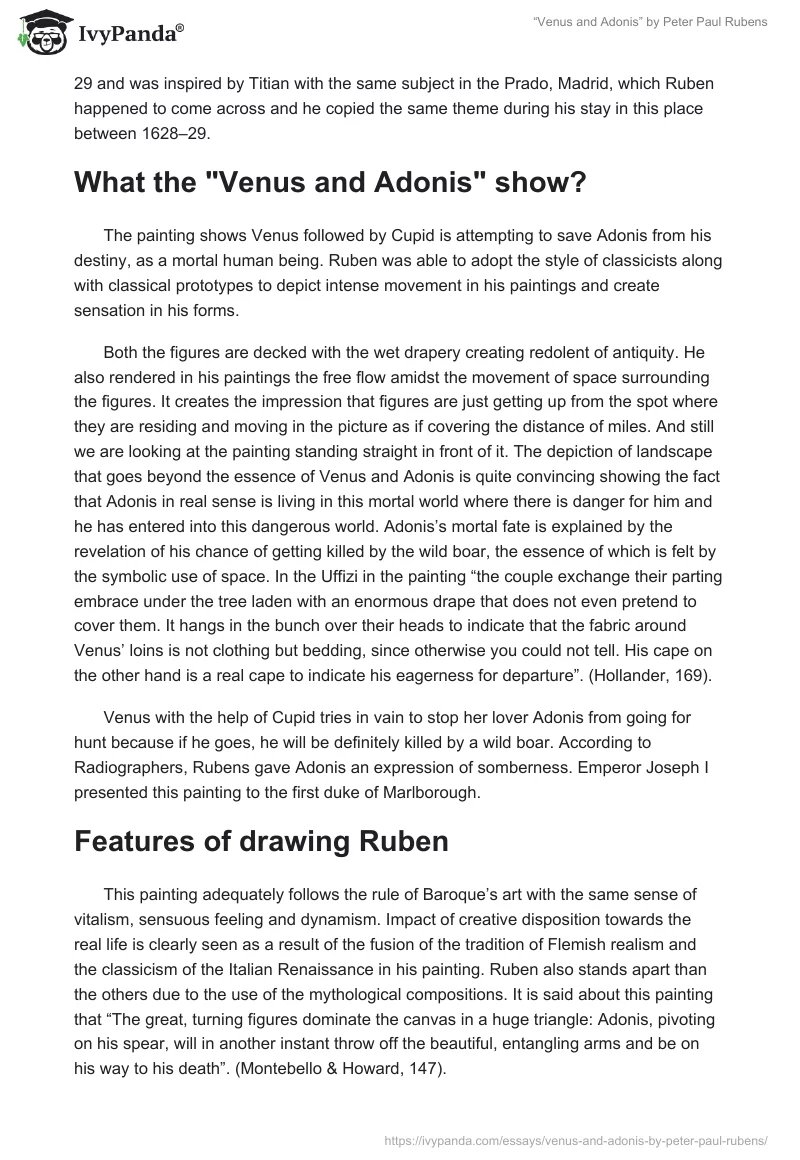Introducion
Peter Paul Rubens (1577-1640) was the greatest exponent of the baroque paintings and the most renowned painter of the Northern Europe. By mixing the realistic tradition of Flemish paintings with the imaginative thoughts and classical themes of Italian Renaissance, he invigorated and redirected Northern European paintings. In his paintings were reflected enduring and captivating scenes of children, portraits of noblemen and women, animal kingdom and nature in its various vicissitude. Ruben is still known for his extraordinary quality and diversity.
There is a spontaneous outpour of strong feelings towards the social upheavals especially religious strife in his paintings. He adopted various styles in his paintings and only few artists had been capable of transforming variety of influences into a style, which is something new and original. He was a devoted Roman Catholic and incorporated the same in many of his religious paintings with the creation of emotional tone as a Counter-Reformation. This deep religious stand, and his association with the societal affairs render him and his works conservative which contradicts the secular paintings of his Dutch contemporary, Rembrandt.
Baroque art
Baroque art was not just the sketches in red, blue or green or many colors but they were real pictures in their own light with the contrast of light and shadow increasing the dramatic effects and psychological upheavals of the persons. The facial expression gives the passionate appeal with the individualism and personalized appeal.
Both the Venus with Mars and the Venus with Adonis were the favorite subjects among the painters of renaissance and Baroque painters and artists especially with Botticelli, Veronese, Marcantonio, and Ruben. (Ziegler, 390) Paul Ruben’s “Venus and Adonis” is a replica of love from classical mythology. This painting dates back to 1628–29 and was inspired by Titian with the same subject in the Prado, Madrid, which Ruben happened to come across and he copied the same theme during his stay in this place between 1628–29.
What the “Venus and Adonis” show?
The painting shows Venus followed by Cupid is attempting to save Adonis from his destiny, as a mortal human being. Ruben was able to adopt the style of classicists along with classical prototypes to depict intense movement in his paintings and create sensation in his forms.
Both the figures are decked with the wet drapery creating redolent of antiquity. He also rendered in his paintings the free flow amidst the movement of space surrounding the figures. It creates the impression that figures are just getting up from the spot where they are residing and moving in the picture as if covering the distance of miles. And still we are looking at the painting standing straight in front of it. The depiction of landscape that goes beyond the essence of Venus and Adonis is quite convincing showing the fact that Adonis in real sense is living in this mortal world where there is danger for him and he has entered into this dangerous world. Adonis’s mortal fate is explained by the revelation of his chance of getting killed by the wild boar, the essence of which is felt by the symbolic use of space. In the Uffizi in the painting “the couple exchange their parting embrace under the tree laden with an enormous drape that does not even pretend to cover them. It hangs in the bunch over their heads to indicate that the fabric around Venus’ loins is not clothing but bedding, since otherwise you could not tell. His cape on the other hand is a real cape to indicate his eagerness for departure”. (Hollander, 169).
Venus with the help of Cupid tries in vain to stop her lover Adonis from going for hunt because if he goes, he will be definitely killed by a wild boar. According to Radiographers, Rubens gave Adonis an expression of somberness. Emperor Joseph I presented this painting to the first duke of Marlborough.
Features of drawing Ruben
This painting adequately follows the rule of Baroque’s art with the same sense of vitalism, sensuous feeling and dynamism. Impact of creative disposition towards the real life is clearly seen as a result of the fusion of the tradition of Flemish realism and the classicism of the Italian Renaissance in his painting. Ruben also stands apart than the others due to the use of the mythological compositions. It is said about this painting that “The great, turning figures dominate the canvas in a huge triangle: Adonis, pivoting on his spear, will in another instant throw off the beautiful, entangling arms and be on his way to his death”. (Montebello & Howard, 147).
Despite of adapting the idea from Titian, he was always eager to add something more in his work and craft more subtlety in his figures, more curves, more sparkling effects whereas Titian, and other Renaissance artists emphasized more on the narration and the storytelling.
Conclusion
“Venus and Adonis” painting is displayed in the Metropolitan Museum of Art in New York. On the one hand Titian produced before us pair of lovers on the other hand Rubens must had a bevy and a mob. Though both the paintings by Titian and Rubens are master pieces, and painting done according to the rules and technologies of that particular period and had an influence from earlier grand artists, and the theme also is same yet both of them adopted their unique style, with originality reflected in both of them and are rare and ideal. Both of these paintings deserve to hold their exclusive place in the history of art and painting.
Works Cited
Hollander, Anna. “Seeing Through Clothes” University of California Press, 1993.
Montebello, Philippe De & Howard, Kathleen. “The Metropolitan Museum of Art Guide”. New York: Metropolitan Museum of Art, 1983.
Ziegler, Georgianna. “Picturing Venus and Adonis: Shakespeare and the artists” in Venus and Adonis: Critical Essays. Ed. Philip C. Kolin. Routledge, 1997. 389-404.


